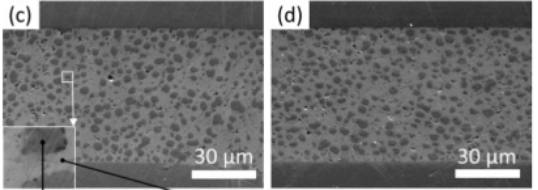Application of Micro-Sized Cu in Power Devices 点击:108 | 回复:1
功率器件产品的应用已扩展到相当多的行业,如汽车、航空航天和军事工业。功率器件需要能够适应更高的工作温度(>250°C),这大大增加了对设备材料的需求。
The application of power device products has expanded to a considerable number of industries, such as automotive, aerospace, and military industries. Power devices need to be able to adapt to higher operating temperatures (>250°C), which significantly increases the demand for equipment materials. Transient liquid phase (TLP) bonding is considered a reliable technique for preparing high-temperature solder joints, which allows soldering at relatively low temperatures while generating higher soldering remelting temperatures. However, TLP bonding takes a long time to completely consume low melting point metals and requires several hours of annealing to form stable solder joints.
1. Micro-sized Cu particles
Liu et al. deposited Sn layers on Cu particles. The average diameter of Cu particles is 6.2μm. The average thickness of Sn coating was about 0.5μm. The Cu particles were then made into a paste consisting of 85wt% particles and 15wt% terpene alcohol solvent. The Cu-Cu solder joint with slurry was preheated in the air at 130°C for 3 mins to evaporate the solvent. The solder joint was continuously heated to 300°C and remained 30s. The heating rate was 1°C/s. The entire process was carried out using a hot press bonding system under an external pressure of 10MPa. A formic acid atmosphere was introduced to reduce the oxide layer on the Sn coating and Cu substrate.

Figure 1. Transient Liquid Phase Sintering (TLPS) Bonding Process.
2. Experimental results
During the TLPS bonding process, Cu6Sn5 IMC is formed at the beginning of the solder joint. As the temperature rises above 210℃, the Sn plating layer of Cu particles gradually melts. As the temperature continues to rise, Sn begins to consume significantly, the number of Cu3Sn begins to increase, and Cu6Sn5 gradually decreases until it disappears completely after heating to 300℃. In high-temperature application environments, solder joints generally do not contain thermally unstable Cu6Sn5 phases. When the composition of the solder joint is located in the Cu-rich region of the Cu-Sn system, Cu6Sn5 tends to transform into Cu3Sn.
As shown in Figure 2, the atomic ratio of Cu to Sn is 3:1 in the gray area of the bonding solder joint. The black particles uniformly distributed in the gray area are Cu particles, indicating that the Cu3Sn IMC phase in the bonding solder joint contains uniformly distributed Cu particles. After aging at 300°C for 200h, the microstructure characteristics of the two-phase mixture are almost consistent with the structure after soldering, indicating that the thermodynamics of the solder joint remains basically stable at this temperature. Importantly, due to the similar microstructures before and after soldering, the strength of the solder joint varies slightly with increasing aging time.

Figure 2. The SEM image of TLPS solder joints. (c) after heating at 300 ℃ for 60s (d) after aging at 300℃ for 200h.
3. Fitech's solder paste
In addition to TLPS bonding, traditional lead-free solder paste can still be used for the soldering of power devices. Shenzhen Fitech has professional experience in the research and production of high-temperature solder paste, which can provide customers with high-quality gold-tin solder paste for high-temperature welding needs. Fitech’s gold-tin solder paste has the advantages of stable viscosity, low residue, and high solder joint strength. Welcomes customers to cooperate with us in depth.
4. Reference
Liu, X.D., He, S.L. & Nishikawa, H. (2016). Thermally stable Cu3Sn/Cu composite joint for high-temperature power device. Scripta Materialia, vol.110, pp.101-104.

官方公众号

智造工程师
-

 客服
客服

-

 小程序
小程序

-

 公众号
公众号


















 工控网智造工程师好文精选
工控网智造工程师好文精选
